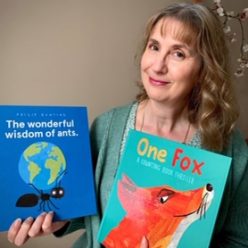Illustrated by Jess Racklyeft

Published by Allen & Unwin, NSW, 2021
Like many unique environments, the flora and fauna of that southern, icy and ever- changing continent of Antarctica is threatened by pollution, global warming and climate change. This picture book helps us to understand what we might lose if sea ice continues to diminish across this vast and seemingly uninhabitable land.
Following the life cycle of an iceberg as it shears off a glacier in spring, we are encouraged to look closely at what appears to be, at first glance, an empty continent. As summer nears, animals appear underwater and on shore: leopard seals, penguins, krill, terns, cormorants, humpback whales, squid and orca. All of them dependant on one another and the ice that surrounds them, for food and a place to rest, eat, mate and reproduce.
The illustrations in this picture book have been made using a combination of water colour, acrylic paint, collage, pencil, ink and digital aids. It is wonderful to see so many different shades of blue. The central pages fold outwards to a double spread revealing some of the creatures living in the ocean. Unfolding it, helps us to reflect upon the immensity of this continent, which is almost twice the size of Australia, by that feeling that it is almost too big to hold on your lap!
Accompanying the illustrations, the text is informative, thoughtful and expressed with poetic clarity. For younger readers, visual imagery is captured with creative descriptions:
Terns wheel overhead. Blue-eyed cormorant too, their wingspans wider than outstretched arms….
Penguins dive deep for fish. Seals dive deeper to twitch-whisker hunt.
For older readers, there are enough hints in the text to embark upon their own research and investigate some of the complexities of this fragile ecosystem:
The iceberg is flat-topped, sharp and angular and carries ancient weather in its layers of ice-clothing; a coat for each year volcanoes blew and black ash fell like snow.
I can highly recommend this picture book for children 4-8 years and below are more suggestions for picture books that delve into the problems of global warming and climate change:


by Lynne Cherry

Illustrated by Michael E. Mann



by Debi Gliori

by Andrew Joyner


by Michael Foreman

by Isabel Sanchez Vegara
Illustrated by Anke Weckmann




by Oliver Jeffers


by Sally Nicholls
Illustrated by Carolina Rabei



by Nick Bland

by Diane Jackson Hill
Illustrated by Craig Smith








